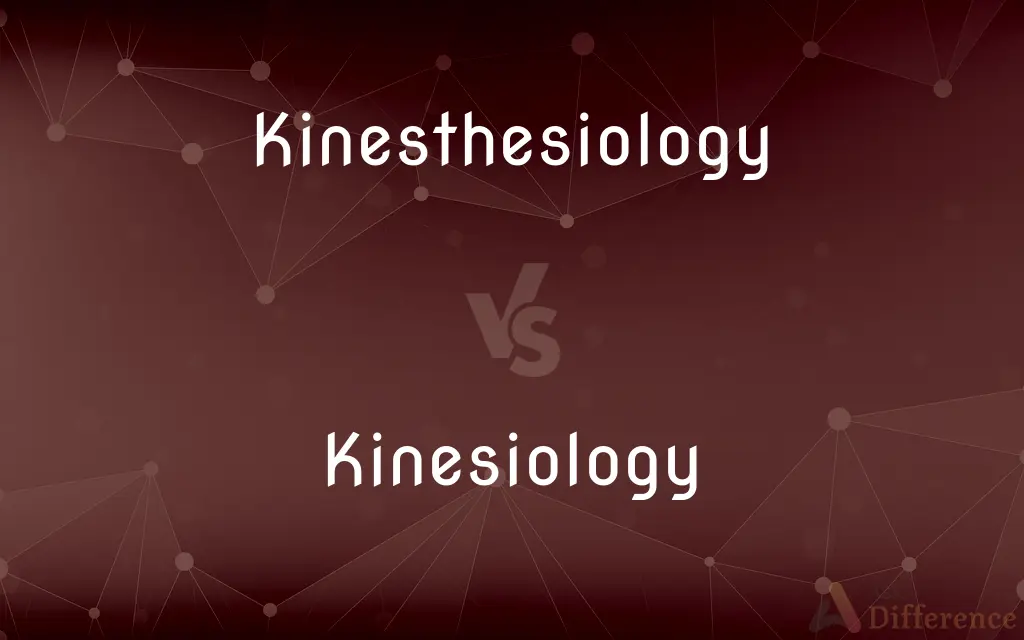Kinesthesiology vs. Kinesiology — What's the Difference?
By Tayyaba Rehman — Updated on May 30, 2024
Kinesthesiology refers to the study of body movement awareness, while Kinesiology is the study of body movement mechanics.

Difference Between Kinesthesiology and Kinesiology
Table of Contents
ADVERTISEMENT
Key Differences
Kinesthesiology delves into the perception and awareness of bodily movement. It is derived from "kinesthesia", which refers to our sense of bodily movement, including the sensation of motion and position. On the other hand, Kinesiology, derived from the Greek word 'kinesis' meaning 'movement', is a comprehensive field that studies the principles and mechanics behind human movement.
In Kinesthesiology, there's an emphasis on how we perceive our own body's movements and how it relates to our sensory experiences. This awareness can be particularly significant in various physical activities and therapies. Kinesiology, on the other hand, primarily involves understanding the biomechanics and physiology of movement, often leaning towards therapeutic or athletic applications.
Kinesthesiology can be thought of as a subfield or subset of Kinesiology. While Kinesiology broadly investigates all aspects of movement, Kinesthesiology focuses on our subjective experience and awareness of that movement. Both fields play a crucial role in disciplines such as physical therapy, sports science, and ergonomics.
Lastly, Kinesthesiology and Kinesiology, though different, intersect in many areas. While one is more introspective and centered on perception, the other is more objective, dealing with the technicalities and mechanics of movement.
Comparison Chart
Definition
Study of body movement awareness
Study of body movement mechanics
ADVERTISEMENT
Derived from
"Kinesthesia" (sense of movement)
"Kinesis" (movement in Greek)
Focus
Perception and awareness of movement
Biomechanics and physiology of movement
Application
Physical awareness in activities and therapies
Therapeutic or athletic movement applications
Relationship
Subset or specific aspect of Kinesiology
Broader study encompassing various movement aspects
Compare with Definitions
Kinesthesiology
Exploration of body movement awareness.
Kinesthesiology plays a pivotal role in enhancing athletes' performance.
Kinesiology
Exploration of physical activity biomechanics.
Through kinesiology, we can optimize ergonomic designs.
Kinesthesiology
Study of movement perception.
Through kinesthesiology, dancers improve their awareness of each motion.
Kinesiology
Science of human movement mechanics.
Kinesiology provides insights into athletic performance enhancements.
Kinesthesiology
Analysis of sensory feedback from movements.
The principles of kinesthesiology are embedded in some therapeutic practices.
Kinesiology
Study of the principles behind bodily motion.
Kinesiology plays a central role in physical therapy treatments.
Kinesthesiology
Delving into the subjective experience of movement.
Through kinesthesiology, therapists can better understand patients' movement perceptions.
Kinesiology
Analysis of body movement dynamics.
The kinesiology of a sprinter's run differs from that of a marathon runner.
Kinesthesiology
Investigation of bodily motion sensitivity.
Kinesthesiology can help individuals regain lost movement sensations after injuries.
Kinesiology
Investigation of physiological aspects of movement.
Kinesiology research has improved our understanding of muscle coordination.
Kinesthesiology
The medical and therapeutic study of the movement of muscles and joints
Kinesiology
Kinesiology is the scientific study of human or non-human body movement. Kinesiology addresses physiological, biomechanical, and psychological dynamic principles and mechanisms of movement.
Kinesiology
The study of the mechanics of body movements.
Kinesiology
The study of the anatomy, physiology, and mechanics of body movement, especially in humans.
Kinesiology
The application of the principles of kinesiology to the evaluation and treatment of muscular imbalance or derangement.
Kinesiology
(medicine) The study of body movement.
Kinesiology
(medicine) The application of such principles to the diagnosis and treatment of muscular imbalance.
Kinesiology
The branch of physiology that studies the mechanics and anatomy in relation to human movement
Common Curiosities
Is the perception of movement the sole focus of Kinesthesiology?
It's the primary focus, but Kinesthesiology also delves into related sensory experiences.
How do Kinesthesiology and Kinesiology intersect in real-world applications?
Both fields are crucial in areas like physical therapy, sports science, and ergonomics.
Can Kinesthesiology be considered a part of Kinesiology?
Yes, Kinesthesiology can be seen as a specific aspect or subset of Kinesiology.
What does Kinesthesiology primarily study?
Kinesthesiology studies the awareness and perception of body movement.
Are there therapeutic applications for Kinesthesiology?
Absolutely, understanding movement perception is pivotal in certain therapeutic practices.
How is Kinesiology different from Kinesthesiology?
Kinesiology studies the mechanics of body movement, while Kinesthesiology focuses on movement awareness.
Does Kinesthesiology only deal with athletes?
No, Kinesthesiology is beneficial for anyone, from dancers to individuals in rehabilitation.
Which field, Kinesiology or Kinesthesiology, has a broader scope?
Kinesiology has a broader scope, encompassing various aspects of movement.
Why is Kinesiology important in sports?
Kinesiology helps in understanding and improving athletic performance through biomechanics.
Can Kinesiology provide insights into injury prevention?
Yes, understanding movement mechanics can aid in injury prevention strategies.
Are there specific careers dedicated to Kinesiology?
Yes, careers in sports science, physical therapy, and ergonomics often rely on Kinesiology.
Is Kinesthesiology related to proprioception?
Yes, both deal with the body's sense of position and movement, though proprioception is broader.
How is Kinesiology applied in everyday life?
From ergonomic design to exercise regimens, Kinesiology principles are everywhere.
Can Kinesthesiology help improve movement efficiency?
Yes, by enhancing one's awareness and perception of movement.
How do the two fields contribute to rehabilitation after injuries?
Kinesiology aids in understanding movement restoration, while Kinesthesiology helps patients regain movement perception.
Share Your Discovery

Previous Comparison
Ser vs. Sir
Next Comparison
Civil vs. CivilianAuthor Spotlight
Written by
Tayyaba RehmanTayyaba Rehman is a distinguished writer, currently serving as a primary contributor to askdifference.com. As a researcher in semantics and etymology, Tayyaba's passion for the complexity of languages and their distinctions has found a perfect home on the platform. Tayyaba delves into the intricacies of language, distinguishing between commonly confused words and phrases, thereby providing clarity for readers worldwide.













































